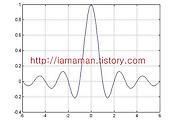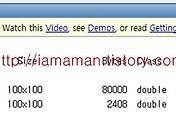오늘은 MATLAB 을 이용한 16 QAM BER Simulation코드에 대해 소개해 보려 합니다.
예전에 제가 작성했던 코드들도 있지만~
아래 주소를 보니 16 QAM 의 Gray coding 부터 이론적인 BER 성능 까지 자세히 설명되어 있더군요.
http://www.dsplog.com/2008/06/05/16qam-bit-error-gray-mapping/
코드는 위 블로그의 약간 아래 쪽을 보시면~ 링크가 되어 있습니다.
못찾으실 분들을 위해 링크를 걸죠, 아래 주소를 오른쪽 클릭한 후에 파일로 다운로드 받거나 그냥 클릭하고 들어가서 전체 선택후에 m 파일에 붙여넣기 해도 됩니다.
혹시 못 찾으실 분들을 위해 코드도 넣습니다. 다시 한번 밝히지만 아래 코드는 Krishna Pillai, http://www.dsplog.com 님이 작성하신 겁니다.
%%%%%%%%%%%%%%%%%%%%%%%%%%%%%%%%%%%%%%%%%%%%%%%%%%%%%%%%%%%%
% All rights reserved by Krishna Pillai, http://www.dsplog.com
% The file may not be re-distributed without explicit authorization
% from Krishna Pillai.
% Checked for proper operation with Octave Version 3.0.0
% Author : Krishna Pillai
% Email : krishna@dsplog.com
% Version : 1.0
% Date : 05 June 2008
% %%%%%%%%%%%%%%%%%%%%%%%%%%%%%%%%%%%%%%%%%%%%%%%%%%%%%%%%%%
% Bit Error Rate for 16-QAM modulation using Gray modulation mapping
clear
N = 10^5; % number of symbols
M = 16; % constellation size
k = log2(M); % bits per symbol
% defining the real and imaginary PAM constellation
% for 16-QAM
alphaRe = [-(2*sqrt(M)/2-1):2:-1 1:2:2*sqrt(M)/2-1];
alphaIm = [-(2*sqrt(M)/2-1):2:-1 1:2:2*sqrt(M)/2-1];
k_16QAM = 1/sqrt(10);
Eb_N0_dB = [0:15]; % multiple Es/N0 values
Es_N0_dB = Eb_N0_dB + 10*log10(k);
% Mapping for binary <--> Gray code conversion
ref = [0:k-1];
map = bitxor(ref,floor(ref/2));
[tt ind] = sort(map);
for ii = 1:length(Eb_N0_dB)
% symbol generation
% ------------------
ipBit = rand(1,N*k,1)>0.5; % random 1's and 0's
ipBitReshape = reshape(ipBit,k,N).';
bin2DecMatrix = ones(N,1)*(2.^[(k/2-1):-1:0]) ; % conversion from binary to decimal
% real
ipBitRe = ipBitReshape(:,[1:k/2]);
ipDecRe = sum(ipBitRe.*bin2DecMatrix,2);
ipGrayDecRe = bitxor(ipDecRe,floor(ipDecRe/2));
% imaginary
ipBitIm = ipBitReshape(:,[k/2+1:k]);
ipDecIm = sum(ipBitIm.*bin2DecMatrix,2);
ipGrayDecIm = bitxor(ipDecIm,floor(ipDecIm/2));
% mapping the Gray coded symbols into constellation
modRe = alphaRe(ipGrayDecRe+1);
modIm = alphaIm(ipGrayDecIm+1);
% complex constellation
mod = modRe + j*modIm;
s = k_16QAM*mod; % normalization of transmit power to one
% noise
% -----
n = 1/sqrt(2)*[randn(1,N) + j*randn(1,N)]; % white guassian noise, 0dB variance
y = s + 10^(-Es_N0_dB(ii)/20)*n; % additive white gaussian noise
% demodulation
% ------------
y_re = real(y)/k_16QAM; % real part
y_im = imag(y)/k_16QAM; % imaginary part
% rounding to the nearest alphabet
ipHatRe = 2*floor(y_re/2)+1;
ipHatRe(find(ipHatRe>max(alphaRe))) = max(alphaRe);
ipHatRe(find(ipHatRe<min(alphaRe))) = min(alphaRe);
ipHatIm = 2*floor(y_im/2)+1;
ipHatIm(find(ipHatIm>max(alphaIm))) = max(alphaIm);
ipHatIm(find(ipHatIm<min(alphaIm))) = min(alphaIm);
% Constellation to Decimal conversion
ipDecHatRe = ind(floor((ipHatRe+4)/2+1))-1; % LUT based
ipDecHatIm = ind(floor((ipHatIm+4)/2+1))-1; % LUT based
% converting to binary string
ipBinHatRe = dec2bin(ipDecHatRe,k/2);
ipBinHatIm = dec2bin(ipDecHatIm,k/2);
% converting binary string to number
ipBinHatRe = ipBinHatRe.';
ipBinHatRe = ipBinHatRe(1:end).';
ipBinHatRe = reshape(str2num(ipBinHatRe).',k/2,N).' ;
ipBinHatIm = ipBinHatIm.';
ipBinHatIm = ipBinHatIm(1:end).';
ipBinHatIm = reshape(str2num(ipBinHatIm).',k/2,N).' ;
% counting errors for real and imaginary
nBitErr(ii) = size(find([ipBitRe- ipBinHatRe]),1) + size(find([ipBitIm - ipBinHatIm]),1) ;
end
simBer = nBitErr/(N*k);
theoryBer = (1/k)*3/2*erfc(sqrt(k*0.1*(10.^(Eb_N0_dB/10))));
close all; figure
semilogy(Eb_N0_dB,theoryBer,'bs-','LineWidth',2);
hold on
semilogy(Eb_N0_dB,simBer,'mx-','LineWidth',2);
axis([0 15 10^-5 1])
grid on
legend('theory', 'simulation');
xlabel('Eb/No, dB')
ylabel('Bit Error Rate')
title('Bit error probability curve for 16-QAM modulation')
실행 시키고 조금만 기다려 보면~~ Krishna Pillai의 블로그에 있는것과 같이 다음과 같은 시뮬레이션 결과를 확인 할 수 있습니다.

위 코드를 배포 하실 때는 원저자를 명시하셔야 합니다.
'programming language > MATLAB' 카테고리의 다른 글
| MATLAB Communication Systems Reference Curves (0) | 2014.04.29 |
|---|---|
| MATLAB PSK(Phase-shift keying) BER simulation (13) | 2014.04.17 |
| MATLAB 원(Circle), 다각형(Polygon) 그리기 (11) | 2014.04.09 |
| MATLAB sinc function (0) | 2014.04.08 |
| MATLAB sparse matrix(희소 행렬) (0) | 2014.02.19 |
| MATLAB 프랙탈(Fractal) Dragon Curve (0) | 2014.01.16 |
| MATLAB 테트리스(Tetris) 게임 (0) | 2014.01.15 |
| MATLAB Game Stellaria (0) | 2014.01.12 |




댓글